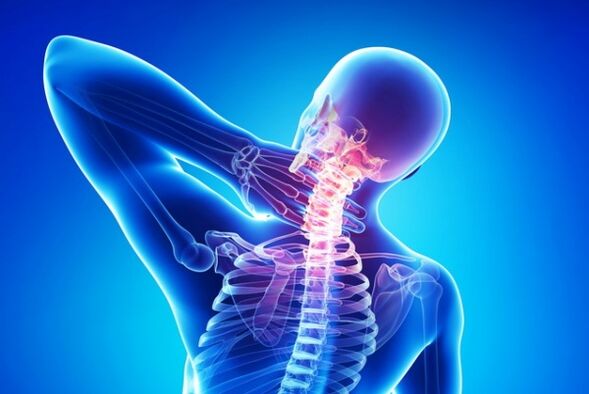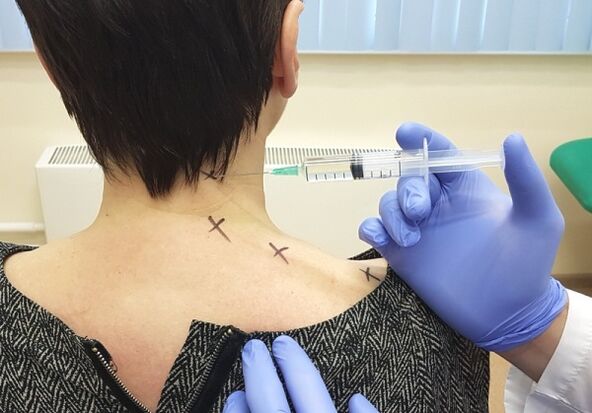Osteochondrosis of the cervical spine is one of the varieties of ordinary osteochondrosis. It is evident through degenerative destruction of windows and neighboring vertebrae. At the same time, arteries and nerve ends are set up in the pathological process. The cervical osteochondrosis has recently become much younger. When the illness was the lot of older people in the last century, today young people between the ages of 23 and 40 suffer, possibly older. Such a dystrophy accounts for up to 40% of the total of the sick.

Reasons
Why does cervical osteochondrosis develop? It has been proven that the most common cause of pathology is the lack of active movements. Sitting with a neck that was extended to the front or a curved head - this is how the working day is passed by office workers and representatives of many other specialties. When you come home, the majority sit for a computer or television again. A similar lifestyle leads to a deterioration in blood flow in the vertebral artery, followed by dystrophy of windows and the destruction of the vertebrae. The factor considered is far from the only culprit of the disease. There are other causes of cervical osteochondrosis. For example, many experts combine great importance for the hypothermia and hereditary weakness of the intermediate tasting joints, ligaments and muscles. The following factors become the starting mechanism for the development of the neck of the osteochondrosis:
- Disorders in the work of the endocrine system;
- flat feet;
- Spinal injuries;
- Violation of attitude;
- unbalanced nutrition;
- High load in the cervix;
- Autoimmune diseases;
- Viruses and infections.
For women in postmenopicions, the cause of the progressive dystrophy of the cervical spine is a decrease in estrogen production with simultaneous development of osteoporosis.
Symptoms
Symptoms of osteochondrosis can occur both at the beginning of the disease and later in the chronic stage. It all depends on the degree of dystrophy, the presence of accompanying pathologies and a combination of unwanted conditions. The main symptoms of osteochondrosis of the cervical spine:
- Hell Bank;
- Migraines, dizziness;
- neurotic disorders;
- Pain and crunch on the neck;
- The weakness of the upper members:
- Impairment of sensitivity;
- Worsening of hearing and seeing, disturbance of the coordination of movements;
- Derivation of performance.
Pain for cervical osteochondrosis can result anywhere - in shoulder, elbow, ear under the shoulder blade. A characteristic feature of unpleasant sensations is a surprise. In an acute attack, symptoms disappear just as unexpectedly as it occurs. Dizziness for osteochondrosis of the neck is often accompanied by disorientation, a ringing in the ears, loss of consciousness, nausea, migraines. Pressures occur several times a day and are poorly suitable for medical correction. The symptoms of damage to the cervical vertebrae that occur in the brain are based on the deterioration in blood flow and the tissue. As a result of the compression of the arteria of spine and oxygen in patients, the following diseases manifest themselves:
- A feeling of fear and panic;
- Irritability;
- Aggression;
- Frequent change of mood;
- Tears;
- Insomnia;
- Worsening of memory and attention;
- Unreasonable outbreaks of anger.
Signs of cervical osteochondrosis in women appear somewhat earlier than in men and go out more. The first symptoms of diseases are usually brain disorders, which are often written off in a PMS or a hormonal failure. Then there is dizziness, migraines, loss of consciousness. The symptoms of cervical osteochondrosis in men do not occur so intensely and often resemble an attack by angina pectoris with shortness of breath, nausea and symptoms behind the star. Only one specialist can determine the real cause of such manifestations, he will be able to provide primary aid so that he should not delay himself with his visit.
degree
Taking into account and analyzing the procedure for the development of changes in the tissue of the vertebrae, the doctors described several stages of osteochondrosis of the cervix region:
- Clinical phase. The cervical osteochondrosis of the 1st degree is expressed by the shift of the pulpoose core to the side and the beginning of the destruction of the fibrous ring. Pain during this time cannot be present, a small lordosis and difficulties when turning or tilting the head are possible.
- Osteochondrosis of the cervical region of the 2nd degree is characterized by an increase in pathological destruction, the instability of the entire segment with subluxis, and pain sometimes appears in the shoulder strap or in the arm. The patient complains about distraction, a deterioration in memory and attention.
- Osteochondrosis of the 3rd degree develops with a complete break of the fiber ring. Neurological symptoms occur, the sensitivity is disturbed. The pain in the third stage becomes constant and disturbs the patient. The mobility of the neck segment worsens.
- Osteochondrosis of the neck 4 degrees. The last phase of the degenerative process. The intervertebral disc is completely replaced by connective tissue, all symptoms are more pronounced, a deterioration in the coordination of movements, ataxia is determined.

Depending on the localization of pain, the following type of illness is differentiated: and cervical. According to the method, the disease is of course common to divide into acute intervertebral osteochondrosis of the neck, which appears for the first time and chronic and extends with constant remissions and deterioration for years.
Which doctor treats cervical osteochondrosis?
The variety of symptoms, which often hide under the mask of another disease, leads to a logical question - which doctor can contact? If pain in the neck, shoulders and hands or the occurrence of neurotic disorders, it is urgent to approach the neurologist. And who you have to contact if there are no such specialists in the local clinic? In this case, the ticket should be moved to the therapist. The doctor prescribes the treatment or sends a close specialization to the doctor.
Diagnosis
The diagnosis of cervical osteochondrosis begins with a visual examination and overview of the patient. The neuropathologist is interested in living and work diseases, the presence of chronic complaints, nutrition and motor activity. A preliminary diagnosis is confirmed by carrying out instrumental research:
- X -Ray in two projections;
- MRI;
- CT;
- Duplex scan.
The analysis of hormones is required for fairer sex. Without them, the treatment of cervical osteochondrosis in women does not begin. In order to exclude pathologies with such symptoms, a differential diagnosis is carried out with the appointment of additional consultations with a surgeon, gynecologist, cardiologist, ophthalmologist and tradition.
Treatment
First aid for sharp pain in the neck segment includes taking anesthetics and ensuring the rest of the affected area. Disconnect therapy - pepper patches, the use of heat ointments helps well. However, such measures cannot be dealt with with the disease. They only temporarily make the patient's condition easier. The treatment of osteochondrosis of the cervical spine is comprehensive. His main goal is to eliminate pain and slow down the destruction of slices and swirls. For this purpose, different types of therapy are prescribed: medication, training therapy, massage, carry an orthopedic collar. The treatment of cervical osteochondrosis in women has a number of characteristics and is primarily aimed at eliminating symptoms in the brain. Another effective remedy for neck pain is physiotherapy. The treatment is prescribed both during worsening and during remission. The following methods go together with symptoms of osteochondrosis:
- Laser;
- Magnetotherapy;
- Ultrasonic;
- Electrophoresis with Novocaine or Eufillin.
Clearly makes the condition of patients with therapeutic massage easier. Only carry it out in the remission stage. In order to achieve a persistent result, the therapy is carried out by a course that consists of 9 to 10 interventions. Healing gymnastics is very effective for osteochondrosis of the cervix region. The strictly dosed load quickly removes symptoms, improves vertebral mobility, strengthens the muscles and improves blood flow. Patients with osteochondrosis often turn recipes for traditional medicine, hoping for a healing. It should be remembered that all non -traditional active ingredients are only permitted as a supplement to the main therapy that is prescribed by the doctor. Is it possible to heal cervical osteochondrosis completely? Unfortunately no. Medicines and other conservative methods can only cancel the dystrophic process and eliminate symptoms. Even after satisfactory therapy, the affected windows are still replaced by connective tissue and lose their functionality.
Complications
Osteochondrosis of the cervical spine is dangerous with its complications. With the undesirable development of the disease, pressing the arteria on spine can lead to a stroke of a brain that affects a continued deterioration of hearing and vision. A hernia, severe hypertension and deafness or cooling of the fingers with osteochondrosis often follow. In women, complications of neurological nature often develop - constant fatigue, lethargy, loss of performance, excessive resentment.
prevention

The prevention of the osteochondrosis of the cervical spine includes affordable physical activity, a balanced diet with sufficient amount of calcium and phosphorus, control over the weight and maintaining the right attitude. All of this should become a habit and only be met from early childhood. Office workers and those who spend many hours behind the monitor screen to prevent the neck osteochondrosis should adhere to simple recommendations:
- Every hour arranges 10-minute breaks in which simple exercises do it;
- At lunchtime they do not sit at work, but go in the fresh air.
- Choose comfortable production furniture that exclude an unpleasant pose.
- Organize good table light.
After a working day, it is recommended to lie on a flat surface without a pillow or ask the household to carry out a light massage. This will help relieve the tension of the neck muscles and relax. Excellent prevention of degenerative changes will not be traumatic sports and swimming. The timely identified and healed osteochondrosis of the cervix region may not manifest itself for many years and enables the patient to live a completely comfortable life. And with regular preventive administration to prevent and treat osteoarthritis of medicinal products, the disease will also stop in old age.





















